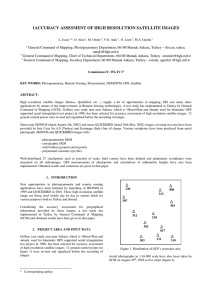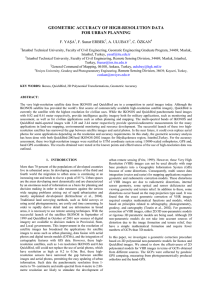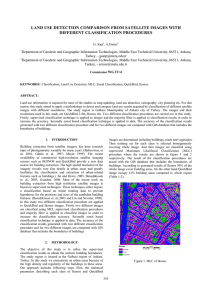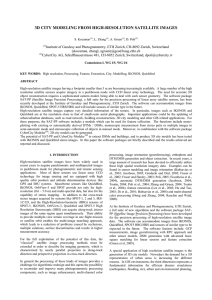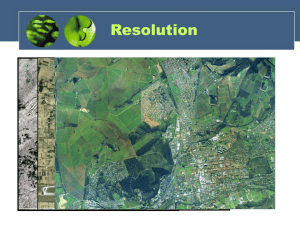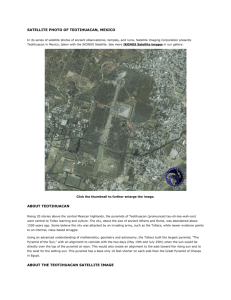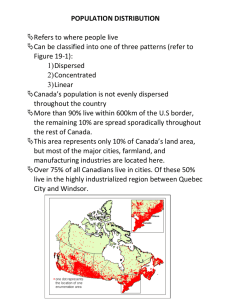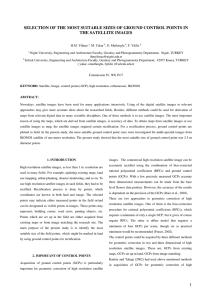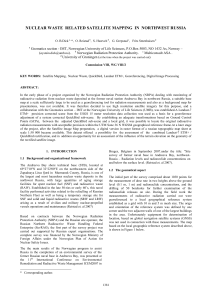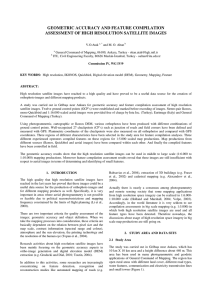THE ASSESSMENT OF HIGH RESOLUTION SATELLITE IMAGES AND
advertisement
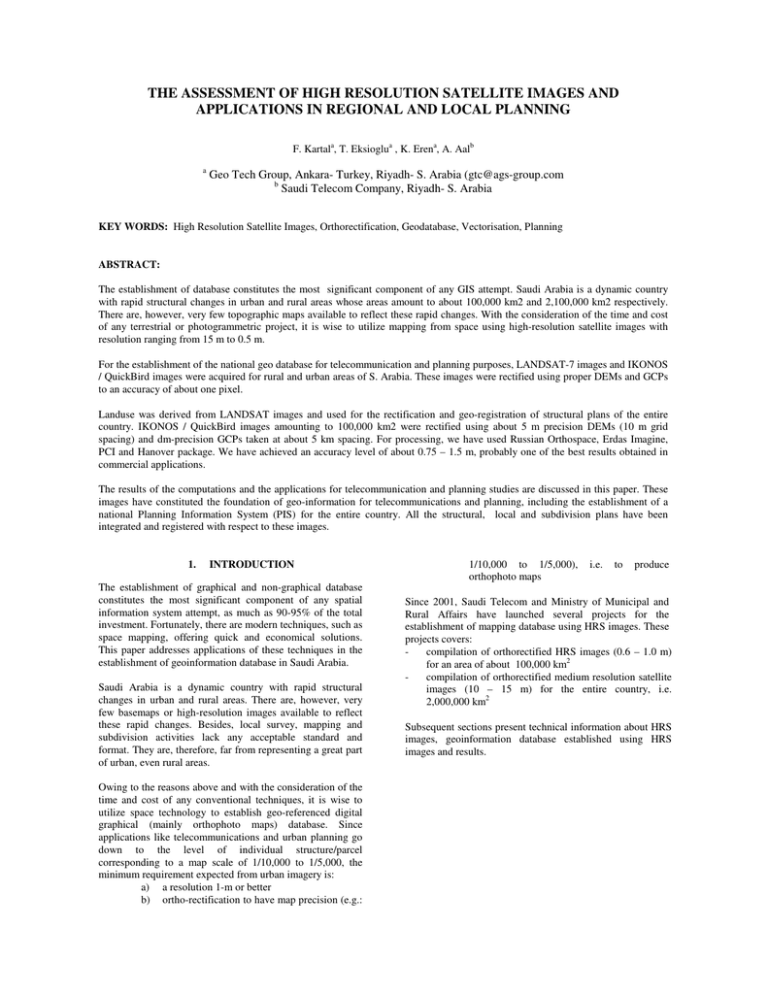
THE ASSESSMENT OF HIGH RESOLUTION SATELLITE IMAGES AND APPLICATIONS IN REGIONAL AND LOCAL PLANNING F. Kartala, T. Eksioglua , K. Erena, A. Aalb a Geo Tech Group, Ankara- Turkey, Riyadh- S. Arabia (gtc@ags-group.com b Saudi Telecom Company, Riyadh- S. Arabia KEY WORDS: High Resolution Satellite Images, Orthorectification, Geodatabase, Vectorisation, Planning ABSTRACT: The establishment of database constitutes the most significant component of any GIS attempt. Saudi Arabia is a dynamic country with rapid structural changes in urban and rural areas whose areas amount to about 100,000 km2 and 2,100,000 km2 respectively. There are, however, very few topographic maps available to reflect these rapid changes. With the consideration of the time and cost of any terrestrial or photogrammetric project, it is wise to utilize mapping from space using high-resolution satellite images with resolution ranging from 15 m to 0.5 m. For the establishment of the national geo database for telecommunication and planning purposes, LANDSAT-7 images and IKONOS / QuickBird images were acquired for rural and urban areas of S. Arabia. These images were rectified using proper DEMs and GCPs to an accuracy of about one pixel. Landuse was derived from LANDSAT images and used for the rectification and geo-registration of structural plans of the entire country. IKONOS / QuickBird images amounting to 100,000 km2 were rectified using about 5 m precision DEMs (10 m grid spacing) and dm-precision GCPs taken at about 5 km spacing. For processing, we have used Russian Orthospace, Erdas Imagine, PCI and Hanover package. We have achieved an accuracy level of about 0.75 – 1.5 m, probably one of the best results obtained in commercial applications. The results of the computations and the applications for telecommunication and planning studies are discussed in this paper. These images have constituted the foundation of geo-information for telecommunications and planning, including the establishment of a national Planning Information System (PIS) for the entire country. All the structural, local and subdivision plans have been integrated and registered with respect to these images. 1. INTRODUCTION The establishment of graphical and non-graphical database constitutes the most significant component of any spatial information system attempt, as much as 90-95% of the total investment. Fortunately, there are modern techniques, such as space mapping, offering quick and economical solutions. This paper addresses applications of these techniques in the establishment of geoinformation database in Saudi Arabia. Saudi Arabia is a dynamic country with rapid structural changes in urban and rural areas. There are, however, very few basemaps or high-resolution images available to reflect these rapid changes. Besides, local survey, mapping and subdivision activities lack any acceptable standard and format. They are, therefore, far from representing a great part of urban, even rural areas. Owing to the reasons above and with the consideration of the time and cost of any conventional techniques, it is wise to utilize space technology to establish geo-referenced digital graphical (mainly orthophoto maps) database. Since applications like telecommunications and urban planning go down to the level of individual structure/parcel corresponding to a map scale of 1/10,000 to 1/5,000, the minimum requirement expected from urban imagery is: a) a resolution 1-m or better b) ortho-rectification to have map precision (e.g.: 1/10,000 to 1/5,000), orthophoto maps i.e. to produce Since 2001, Saudi Telecom and Ministry of Municipal and Rural Affairs have launched several projects for the establishment of mapping database using HRS images. These projects covers: compilation of orthorectified HRS images (0.6 – 1.0 m) for an area of about 100,000 km2 compilation of orthorectified medium resolution satellite images (10 – 15 m) for the entire country, i.e. 2,000,000 km2 Subsequent sections present technical information about HRS images, geoinformation database established using HRS images and results. 2. HIGH-RESOLUTION SATELLITE IMAGES (HRS) A photogrammetric breakthrough has been realised by the use of space images. The earth observation started with photographic cameras used for national security reason (Lavrov, 2000). However, the first digital space camera system used in space, especially designed for unclassified mapping purposes was SPOT 1, launched in February 1986. It was followed by SPOT 2, 3, 4 and others such as IKONOS and QuickBird. More detailed information on space cameras, space images and space mapping can be found in Jacobsen (2001a,b). The features of the satellites used in the projects subject to this paper are listed in Table 1. They play a very significant role as many countries have an intense need for detailed, accurate satellite imagery for a multitude of important applications, such as mapping, agricultural monitoring, resource management and urban planning. A brief discussion on IKONOS and QuickBird images, GCPs, DEMs and orthorectification is provided subsequent sections. Figure 1. IKONOS image in Riyadh Table 1. The main features of HRS used in our projects company or first country launch number of pixel mode Quick Bird 2 Earth Watch 2001 27000 Ikonos active since 2000 Space Imaging EOSAT 13816 Resours 21 Resours 21 failed April 99 success Sept 99 2001 SPOT 5 SPOT Image 2002 12000 Landsat 7 USA pan multispr 4 bands 11 bit pan multisp. 4 bands 11bit multisp 5 bands pan multisp 4 bands ETM+ pan multisp 7 bands 6700 3454 2000 6000 1 since April 99 16 pixel size (nadir) 0.61 swath [km] pointing in-track pointing across height orbit storage 17 17 +/-30° +/-30° 450km inclinat. 52 64 scenes – 11.3 +/-45° +/-45° 680 sunsynchr 64Gb 205 +/-30° +/-40° 743 176 Gb 30 +/-19.2° +/-27° 830 60 185 sun synchr sunsynchr -- -- 705 sunsynchr 375Gb 2.44 0.82 2.0 3.2-8 10 20 MIR 2.5 10 20 MIR 15 30 60 TIR 132Gb 2.1 IKONOS Images 2.2 QUICKBIRD Images The world’s first commercial, high-resolution imaging satellite has been successfully launched on Sept. 24, 1999 from Vandenberg Air Force Base. The 720 kg IKONOS was launched into a sun-synchronous, near-polar, circular lowEarth orbit. The QuickBird Satellite was launched on October 18th, 2001 at Vandenberg Air Force Base in California. The satellite is positioned at an Orbit altitude of 450 Km with an orbit inclination of 97.2°, sun-synchronous. IKONOS is the first commercial imaging satellite of its kind. It simultaneously collects one-meter resolution black-andwhite (panchromatic) images and four-meter resolution colour (multispectral) images. Designed to take digital images of the Earth from 400 miles (680 kilometres) up and moving at a speed of about four-and-a-half miles (seven kilometres) per second, the satellite camera can distinguish objects on the Earth’s surface as small as one meter square in size. One of the pictures of this satellite belonging to our project area is shown in Fig. 1. The QuickBird Satellite sensor provides Panchromatic (P) Image data at 11 bits with a pixel resolution of 0.61 m at nadir to 0.72 m at 25° off-nadir and MultiSpectral (MS) Image data at 11 bits with a pixel resolution of 2.44 m at nadir to 2.88 m at 25° off-nadir. The swath width of the QuickBird Satellite is 16.5 km at nadir. Pan sharpened Natural Color Standard or Ortho Image data is provided with a pixel resolution of 0.7 m. The 0.61 m to 0.72 m Pan-sharpened Panchromatic or Natural Color products can be used for a wide variety of applications and represents the highest resolution satellite imagery currently commercially available. The satellite carries a state-of-the-art sensor and is the most advanced commercial imaging system in orbit. One of the pictures of this satellite belonging to our project area is shown in Fig. 2. 1.5 pixels was performed very successfully. The orthorectification process was carried out using Russian OrthoSpace, which uses a dynamic model without requiring sensor camera parameters and / or PCI with sensor parameters and rational polynomial coefficients. The mosaicking was carried out using IRAS-C software. 3. SAUDI GEODATABASE USING HRS IMAGES AND PLANS 3.1 Image Geodatabase Using HRS images, a very comprehensive geodatabase was established. It consists of about 100,000 km2 of IKONOS and QuickBird images (Fig. 3) 2,000,000 km2 of LANDSAT-7 images (Fig. 4) structural plans of the entire Saudi Arabia local plans and subdivisions of Qaseem, Riyadh and Aseer regions (Fig. 5) Figure 2. QuickBird image in Riyadh 2.3 Ground Control Points (GCPs) In the orthorectification of HRS images, GCPs play very significant role. For IKONOS and QuickBird images, GCPs were established to dm-level accuracy at a spacing of about 5 km. In case of LANDSAT-7 images, GCPs were established to m-level accuracy at a spacing of about 50 km. In order to establish GCP archive to be used in future, for each GCP, a description card was prepared and in many cases photos were also taken at these points from a short and medium range. The coordinates of GCPs were determined in the national datum (Shedayed et al., 1992) as well as the WGS84 datum. Figure 3. IKONOS & QuickBird coverage (100,000 km2) 2.4 Digital Elevation Models (DEMs) It is to be noted that the IKONOS Geo product and QuickBird Basic and Standard Ortho Ready Imagery Data requires to be processed with the refined Image Support Data (ISD) set, including the orbital parameters of the sensor, GCPs and a Digital Elevation Model (DEM), to obtain the Image accuracy at the level of 1.0 – 1.5 pixels. The accuracy and resolution of the DEM required for the orthorectification of the Satellite Images is depending on the Image georeference position accuracy specified by the Customer. Since it is aimed to have 1.0 – 1.5 pixel accuracy in our projects, a DEM with an accuracy of at least 5 meters is required. 2.5 Orthorectification The system corrected satellite images are subject to errors and distortions due to height differences and lack of precise ground control points. These errors may be as big as 50 meters in case of the system corrected HRS images depending on the magnitude of vertical angle and topographic relief. As part of this project, the orthorectification of IKONOS and QuickBird images to 1.0 – Figure 4. LANDSAT-7 and structural plans coverage (2,000,000 km2) including using Russian TK-350 stereo photographs (Fomtchenko et al., 2000). Since our tests have not yielded satisfactory results, we decided to use existing topographic maps. The DEMs used in the orthorectification of IKONOS & QuickBird images were compiled from topographic maps of 1/10000 – 1/50000 depending on the roughness of the topography. The compiled DEMs were checked by external control measurements For this purpose, a total of 1242 checkpoints / GCPs which have height accuracy better than 1 m. These heights were compared against those obtained from DEMs’ database. The RMS values obtained from comparison are tabulated for each area in Table 3. The overall RMS value is 6.48 m. Additional tests and comparisons are under way. Table 3. IKONOS / QuickBird DEM areas and test results Figure 5. Local plans coverage (840,000 km2) The LANDSAT-7 images were orthorectified using GCPs spaced at about 50 km spacing and DEMs of 30 m postings. A geometric accuracy of about 15 – 20 m was achieved. The landuse of about 20 categories were derived using these images. The IKONOS and QuickBird images were orthorectified using GCPs spaced at about 5 km spacing and DEMs of 10 m postings. A total of about 6000 GCPs were established. A geometric accuracy of about 1.0 – 1.5 m was achieved. This is probably one of the biggest and most successful projects solving the need of fundamental geodatabase of a country. A seamless database of 100,000 km2 was established using orthorectified IKONOS and QuickBird images. Thus, Saudi Arabia has a very reliable, georeferenced and complete HRS image database which will be the foundation for other spatial data such as telephone network, land database, planning, etc. The orthorectified IKONOS & QuickBird images were checked by the Consultant of the project independently. For checking purposes 9-16 uniformly distributed points were picked in 9 areas covered by IKONOS images. These points were GPS surveyed and these coordinates were compared against those read from orthorectified images. The RMS values obtained from comparison are tabulated in Table 2. The overall RMS value of comparison is 1.59 m. The tests in other areas are under progress. Area Region Najran Gizan Aseer Baha Hail Riyadh Jeddah Dammam Arar / Area (km2) 1620 2205 3050 1600 1010 7330 4840 4370 1750 Number of Check Points 50 147 95 231 69 212 255 77 106 RMS values of DEM checking 2.54 m 7.34 m 8.02 m 6.90 m 7.18 m 6.83 m 5.66 m 4.64 m 5.74 m 3.2 Planning Geodatabase Ministry of Municipal and Rural Affairs is responsible for planning of Saudi Arabia. The Ministry had structural and local plans, all as hardcopy and lacking acceptable geometric accuracy, standard and format. One good example to this problem is illustrated in Fig. 6. Over 2000 structural plans, which covers the entire S. Arabia (13 regions), were digitized and georegistered using existing topographic maps and LANDSAT-7 database mentioned above. As can be seen in Table 4, For 3 regions, namely Qaseem, Riyadh and Aseer (see Fig. 5), over 29,000. km2 of IKONOS and QuickBird images were used to i) update structural plans of 685 sheet (see Table 5) ii) rectify local and subdivision plans of 619 sheet (see Table 6). Table 2. Orthorectified IKONOS test results AREA REGION (km2) Najran 1620 Gizan 2205 Aseer 3050 Baha 1600 Hail 1010 Arar 1750 Riyadh 7330 Jeddah 4840 Dammam 4370 Number of RMS Test Points ERROR (m) 8 2.02 9 1.59 15 1.79 12 0.88 9 1.04 13 1.33 12 2.29 14 1.32 16 1.60 108 1.59 m First, possible DEM collection techniques were examined, Figure 6. An existing local plan against IKONOS image Table 4. Ikonos / QuickBird Satellite Images Used REGION Aseer Region Al-Qaseem Region Riyadh Region TOTAL Ikonos/QuickBird Coverage km2 8,926 5,218 15,178 29,322 Table 5. Total Number of Structural Plans processed REGION Hardcopy Rectified Aseer 280 169 Al-Qaseem 243 158 Riyadh 516 358 TOTAL 1039 685 Table 6. Total number of local plans / subdivisions processed Area Km2 REGION Hardcopy Rectified ASIR 358 199 113 QASSIM 661 246 95 Riyadh 373 174 93 TOTAL 1392 619 301 4. PLANNING INFORMATION SYSTEM (PIS) APPLICATIONS AND GTVS A comprehensive geodatabase, consisting of rectified images and plans together with their associated attribute data, was created on the ESRI platform and Planning Information System of MOMRA (MOMRA-PIS) was established. . User friendly application programs were developed for Server, Intranet and Internet applications in order to carry out basic query, search, view, analysis and output. Some examples to the output of MOMRA-PIS can be seen in Figs. 7a, and 7b. Figure 7b. An example to MOMRA-PIS Digital Elevation Models (DEMs) can be utilized in support of 3D Terrain Visualization and Modelling. We have developed a powerful package called, Geotech Terrain View Suite (GTVS), to create 3DTerrain conditions with manually Flythrough capabilities providing the user with a good decision tool for the planning of local and regional projects (www.gtvs.net). 5. RESULTS There is lack of geographic data in some Middle East Countries. For this reason and with the consideration of the time and cost of any terrestrial or photogrammetric project, it is wise to utilize space technology to establish geodatabase. Satellite imagery is a good resource for precision mapping in these countries. Thus, this project is a successful example and shows a simple but powerful solution to developing and even developed countries lacking up-to-date database and GIS operations. REFERENCES Fomtchenko M.M., Chekalin V.F., the use of Russian TK350 images and GPS points in generation of DEM, 2000, SovinformSputnik, Commission IV, Working Group 4, Russia. Jacobsen K., “Geometric Aspects of the Handling of Space Images”, ISPRS Commission I, WG I/5, 2001a. Jacobsen K., “Requirements for Topographic Maps Produced from Space and Current Sensor Systems”, Hanover University, 2001b. Figure 7a. An example to MOMRA-PIS Lavrov V.N., Mapping with the use of Russian space high resolution images, 2000, SovinformSputnik, Russia. Shedayed A., Eren K., Nakiboglu M., MacRitchie S., AlKadi I., Al-Haidey H., Alshammari A., "A Unified Geodetic Reference for Mapping and Land Information Systems", King Abdulaziz City for Science and Technology of Saudi Arabia, Final Report (116 pages), 1992.
